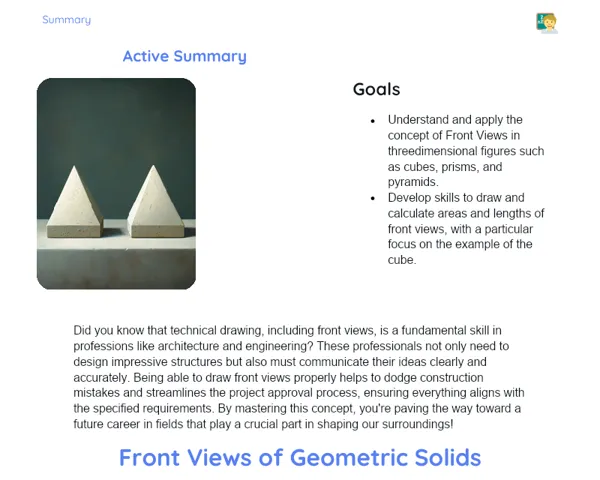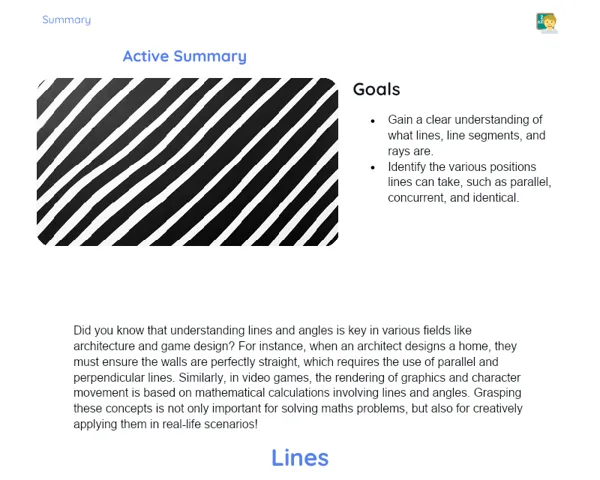Summary Tradisional | Spatial Geometry: Surface Area of the Pyramid
Contextualization
Spatial geometry is a branch of mathematics that focuses on three-dimensional shapes, which have width, height, and depth. In this field, the pyramid is a notable geometric figure, recognised in both historical and contemporary contexts. A pyramid has a polygonal base and triangular faces that converge at a single point known as the vertex. This type of geometric solid is frequently applied in architecture and engineering, and it serves as a classic example in geometry classes due to its straightforward yet rich mathematical properties.
Learning how to calculate the surface area of pyramids is vital for numerous practical applications. From building monuments to various civil engineering projects, familiarity with the formulas for determining both the lateral and total surface areas of a pyramid is crucial. These equations not only aid in figuring out the materials needed for construction but also deepen our comprehension of the geometry behind these shapes. Throughout our lesson, we delved into how to apply these formulas across different pyramid types, highlighting the variations in calculations based on the base shape.
To Remember!
Definition of Pyramid
A pyramid is a geometric solid defined by a polygonal base and triangular faces that meet at a common point called the vertex. The base can be any polygon, like a triangle, square, or pentagon. The triangular faces are known as lateral faces, and the height of the pyramid is the perpendicular distance from the vertex to the base.
This geometric solid is a classic example that appears in both historical and contemporary settings, primarily recognised for its role in ancient monuments such as the Egyptian pyramids. However, pyramids are also integral in various modern architectural and civil engineering projects due to their structurally efficient shape.
Grasping the definition of a pyramid is essential when studying its geometric properties, including surface area calculations. The pyramid serves as an excellent model for exploring spatial geometry concepts because of its relatively simple structure coupled with rich mathematical characteristics.
-
A pyramid consists of a polygonal base and triangular faces.
-
The vertex is where all triangular faces converge.
-
The height is the perpendicular distance from the vertex to the base.
Formulas for Area Calculation
Calculating the surface area of a pyramid involves figuring out the areas of its lateral faces and the base. The formula for calculating the lateral surface area of a pyramid is the total area of the triangular faces. To find the area of a triangular face, we use the triangle area formula: (base × height) / 2.
The total surface area of a pyramid is the sum of the lateral surface area and the base area. The formula for total area varies based on the type of base. For instance, in a pyramid with a square base, we calculate the area of the square and add it to the area of the four triangular faces. In contrast, for a pyramid with a triangular base, we calculate the area of the triangular base and add it to the area of the three triangular faces.
Understanding and applying these formulas is key to tackling problems related to pyramids. Practising with different pyramid types is crucial for ensuring a thorough understanding and the ability to solve a wide range of geometric problems.
-
The lateral surface area is the total area of the triangular faces.
-
The formula for the area of a triangle is (base × height) / 2.
-
The total area is the combined area of the base and the lateral area.
Practical Examples
To illustrate the application of area calculation formulas, let’s look at some practical examples. Firstly, consider a pyramid with a square base where each side measures 4 cm and the height of each triangular face is 6 cm. We calculate the area of one triangular face using (4 cm × 6 cm) / 2 = 12 cm². With four triangular faces, the lateral area totals 4 × 12 cm² = 48 cm². The area of the square base is 4 cm × 4 cm = 16 cm², therefore the total area is 48 cm² + 16 cm² = 64 cm².
Another example features a pyramid with a triangular base, the side lengths being 3 cm, 4 cm, and 5 cm, with the height of each triangular face being 7 cm. Heron’s formula is used to calculate the base area: semiperimeter (s) = (3 cm + 4 cm + 5 cm) / 2 = 6 cm, and the base area = √[s(s - a)(s - b)(s - c)] = √[6(6 - 3)(6 - 4)(6 - 5)] = √36 = 6 cm². After calculating the triangular faces’ areas and summing them, we obtain the lateral area and total area.
These examples demonstrate how to apply the formulas in various scenarios, underscoring the significance of practicing with different types of pyramids to solidify understanding.
-
Calculate the area of both the base and triangular faces.
-
Use Heron’s formula for triangular bases.
-
Sum the areas to find the total surface area.
Guided Problem Solving
Problem-solving is a crucial aspect of reinforcing learning about calculating the surface areas of pyramids. During the lesson, we approached problems step-by-step to demonstrate correct formula application. One problem we tackled involved calculating the lateral area of a pyramid with a square base, each side measuring 4 cm, and the height of each triangular face at 6 cm. This solution required calculating one triangular face's area and then multiplying it by the number of faces.
Another exercise focused on a pyramid with a triangular base, side lengths of 3 cm, 4 cm, and 5 cm, with a height of 7 cm. We employed Heron’s formula for the base area and then determined the area of the triangular faces. Adding these areas gave us the total surface area. These examples guided students through applying formulas in diverse situations.
Practicing problem-solving helps students internalise processes and recognise potential challenges. Additionally, this practice emphasises the need for accuracy in calculations and a clear understanding of problem-solving steps in geometry.
-
Solve problems step by step.
-
Apply formulas across varying situations.
-
Identify and rectify issues in calculations.
Key Terms
-
Pyramid: A geometric solid with a polygonal base and triangular faces converging at a common vertex.
-
Lateral Surface Area: The total area of the triangular faces on the pyramid.
-
Total Surface Area: The combined area of the base and the lateral surface of a pyramid.
-
Heron's Formula: A method for calculating the area of a triangle from the lengths of its sides.
Important Conclusions
In this lesson, we covered the definition and properties of pyramids, focusing specifically on how to calculate their lateral and total surface areas. We established that a pyramid is a geometric solid with a polygonal base and triangular faces meeting at a common vertex, and that the lateral surface area is the sum of the areas of these triangular faces. We discussed and applied essential formulas for these calculations, including Heron’s formula for triangular bases, through practical examples to ensure full comprehension.
Understanding these formulas and methods for calculating the surface areas of pyramids is vital across numerous practical fields, such as architecture and civil engineering. This knowledge allows us to estimate the materials required for pyramid structures and appreciate the geometric complexity of these shapes. By engaging with practical examples and guided problem-solving, we witnessed how to apply these formulas in varied contexts, reinforcing the significance of precision and ongoing practice.
I encourage everyone to deepen their knowledge of this topic, as mastering these skills is not only essential for mathematics, but also for a wide array of practical applications. The geometry of pyramids, with its fascinating history and contemporary relevance, offers a rich and engaging area for exploration and continuous learning.
Study Tips
-
Review the formulas and examples discussed during the lesson, practising with different pyramid types to solidify your understanding.
-
Try solving additional problems from textbooks and online resources with an emphasis on applying the formulas in varying scenarios.
-
Study in groups to discuss and tackle problems with your peers, sharing insights and problem-solving strategies.



